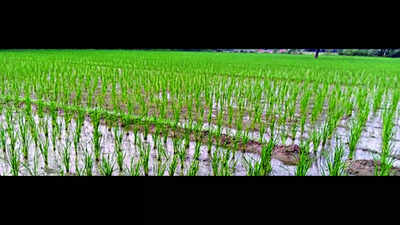Trending
This story is from August 23, 2021
25% of basmati rice crop hit by Bakanae disease in Kasganj
Continuous rainfall and poor sunshine over the past few weeks has adversely affected a high quality variety of basmati rice sown across 16,000 hectare of land in Kasganj district. At least 25% of this delicately fragrant rice has been affected by seed borne fungal disease, Bakanae, according to farmers here.

Paddy is a major kharif crop in Kasganj district
AGRA: Continuous rainfall and poor sunshine over the past few weeks has adversely affected a high quality variety of basmati rice sown across 16,000 hectare of land in Kasganj district. At least 25% of this delicately fragrant rice has been affected by seed borne fungal disease, Bakanae, according to farmers here.
Paddy is a major kharif crop in Kasganj district.
Bakanae is a seedborne fungal disease that infects plants through the roots or crowns. It then grows systematically within the plant. The infected plants are conspicuous as they are abnormally tall with pale, thin leaves. The affected plants produce fewer tillers (grain bearing branches) and produce only partially filled or empty grains.
On its part, the district agriculture department has sounded an alert for Bakanae disease. Farmers are being updated on remedies to prevent crop loss.
Farmers are worried. Jaipal Singh, a paddy farmer of Ratanpur village, said, “Plants are showing abnormal growth and not bearing grain. Some of the plants have rotted. Around 25% of the crop is affected. We have informed the agriculture department about the damage to the crop but so far, no official has come for inspection and guide us to prevent our entire crop from the disease.”
District agriculture officer Kumar advised that farmers should uproot the diseased plant and bury it to prevent further spread of the infection. “In severe conditions, we are recommending use of a few permitted chemicals to prevent damage to the crop. Our teams are going to villages to guide farmers. In case of doubt, farmers can also directly contact agriculture officers using mobile numbers available on the department's website,” he added.
Paddy is a major kharif crop in Kasganj district.
Bakanae is a seedborne fungal disease that infects plants through the roots or crowns. It then grows systematically within the plant. The infected plants are conspicuous as they are abnormally tall with pale, thin leaves. The affected plants produce fewer tillers (grain bearing branches) and produce only partially filled or empty grains.
On its part, the district agriculture department has sounded an alert for Bakanae disease. Farmers are being updated on remedies to prevent crop loss.
Kasganj district agriculture officer Sumit Kumar said, “Bakanae is a seed borne disease caused by the fungus, Gibberella fujikuroi. It can significantly affect the crop yield. Following high moisture and less sunshine, cases of Bakanae disease have surfaced in different parts of the district. In this regard, we have issued an advisory for the farmers.”
Farmers are worried. Jaipal Singh, a paddy farmer of Ratanpur village, said, “Plants are showing abnormal growth and not bearing grain. Some of the plants have rotted. Around 25% of the crop is affected. We have informed the agriculture department about the damage to the crop but so far, no official has come for inspection and guide us to prevent our entire crop from the disease.”
District agriculture officer Kumar advised that farmers should uproot the diseased plant and bury it to prevent further spread of the infection. “In severe conditions, we are recommending use of a few permitted chemicals to prevent damage to the crop. Our teams are going to villages to guide farmers. In case of doubt, farmers can also directly contact agriculture officers using mobile numbers available on the department's website,” he added.
End of Article
FOLLOW US ON SOCIAL MEDIA











